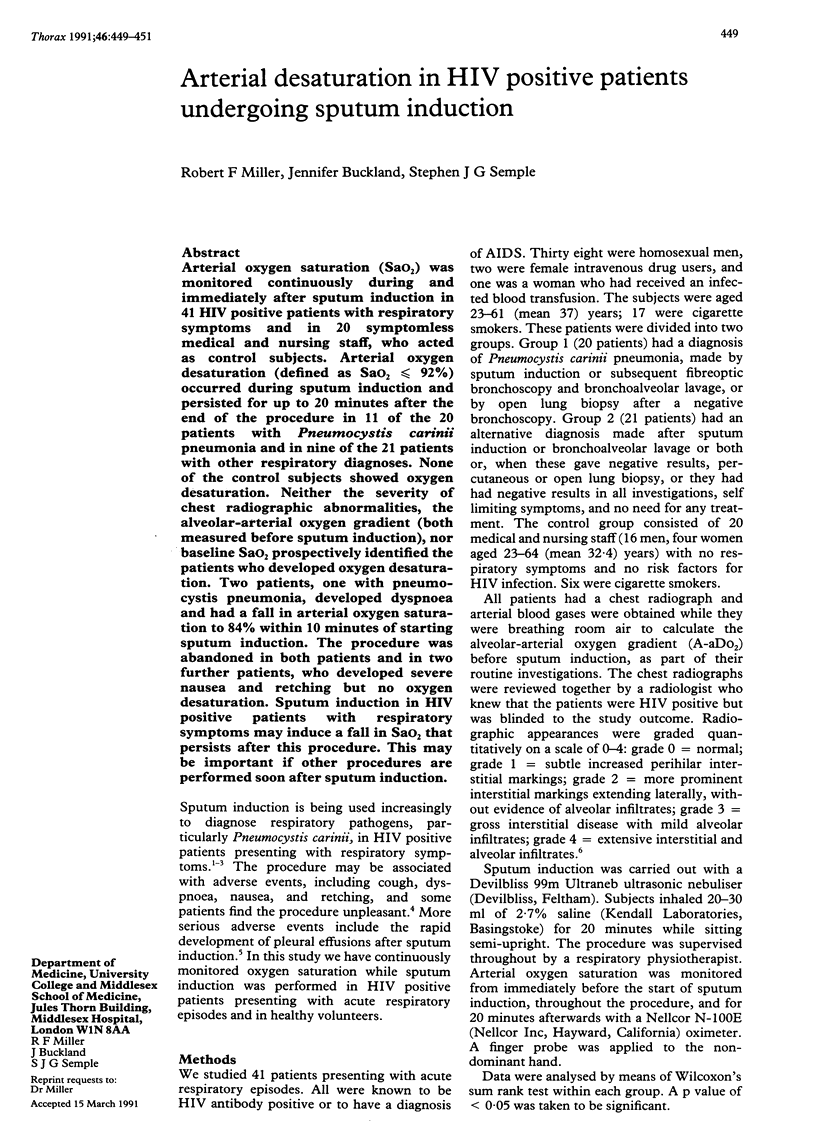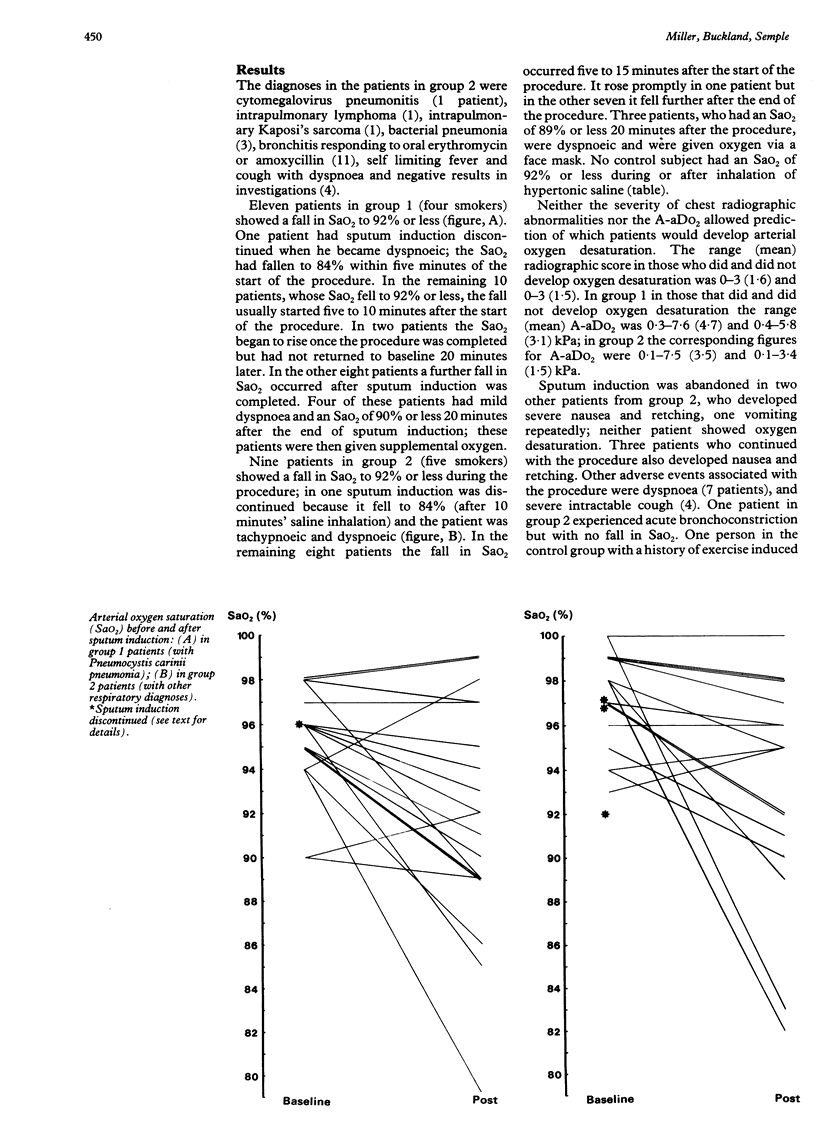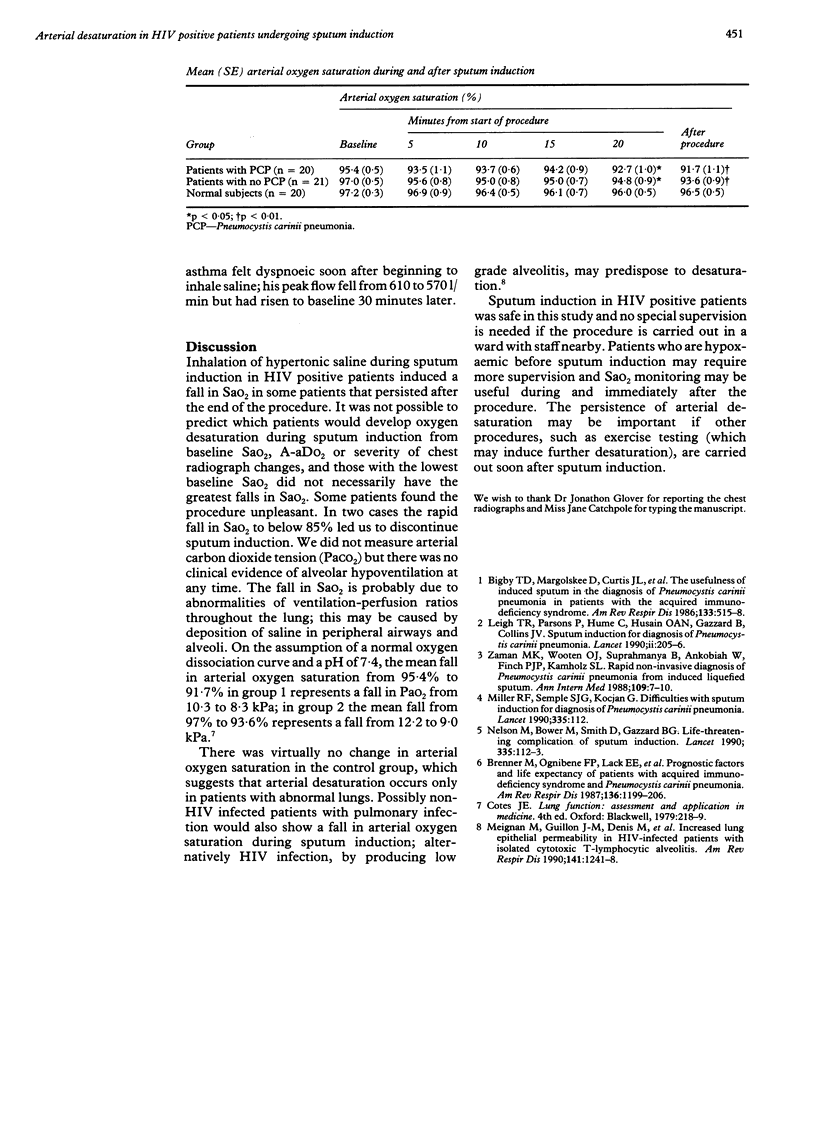Abstract
Arterial oxygen saturation (SaO2) was monitored continuously during and immediately after sputum induction in 41 HIV positive patients with respiratory symptoms and in 20 symptomless medical and nursing staff, who acted as control subjects. Arterial oxygen desaturation (defined as SaO2 less than or equal to 92%) occurred during sputum induction and persisted for up to 20 minutes after the end of the procedure in 11 of the 20 patients with Pneumocystis carinii pneumonia and in nine of the 21 patients with other respiratory diagnoses. None of the control subjects showed oxygen desaturation. Neither the severity of chest radiographic abnormalities, the alveolar-arterial oxygen gradient (both measured before sputum induction), nor baseline SaO2 prospectively identified the patients who developed oxygen desaturation. Two patients, one with pneumocystis pneumonia, developed dyspnoea and had a fall in arterial oxygen saturation to 84% within 10 minutes of starting sputum induction. The procedure was abandoned in both patients and in two further patients, who developed severe nausea and reaching but no oxygen desaturation. Sputum induction in HIV positive patients with respiratory symptoms may induce a fall in SaO2 that persists after this procedure. This may be important if other procedures are performed soon after sputum induction.
Full text
PDF


Selected References
These references are in PubMed. This may not be the complete list of references from this article.
- Bigby T. D., Margolskee D., Curtis J. L., Michael P. F., Sheppard D., Hadley W. K., Hopewell P. C. The usefulness of induced sputum in the diagnosis of Pneumocystis carinii pneumonia in patients with the acquired immunodeficiency syndrome. Am Rev Respir Dis. 1986 Apr;133(4):515–518. doi: 10.1164/arrd.1986.133.4.515. [DOI] [PubMed] [Google Scholar]
- Brenner M., Ognibene F. P., Lack E. E., Simmons J. T., Suffredini A. F., Lane H. C., Fauci A. S., Parrillo J. E., Shelhamer J. H., Masur H. Prognostic factors and life expectancy of patients with acquired immunodeficiency syndrome and Pneumocystis carinii pneumonia. Am Rev Respir Dis. 1987 Nov;136(5):1199–1206. doi: 10.1164/ajrccm/136.5.1199. [DOI] [PubMed] [Google Scholar]
- Leigh T. R., Parsons P., Hume C., Husain O. A., Gazzard B., Collins J. V. Sputum induction for diagnosis of Pneumocystis carinii pneumonia. Lancet. 1989 Jul 22;2(8656):205–206. doi: 10.1016/s0140-6736(89)90382-6. [DOI] [PubMed] [Google Scholar]
- Meignan M., Guillon J. M., Denis M., Joly P., Rosso J., Carette M. F., Baud L., Parquin F., Plata F., Debre P. Increased lung epithelial permeability in HIV-infected patients with isolated cytotoxic T-lymphocytic alveolitis. Am Rev Respir Dis. 1990 May;141(5 Pt 1):1241–1248. doi: 10.1164/ajrccm/141.5_Pt_1.1241. [DOI] [PubMed] [Google Scholar]
- Miller R. F., Semple S. J., Kocjan G. Difficulties with sputum induction for diagnosis of Pneumocystis carinii pneumonia. Lancet. 1990 Jan 13;335(8681):112–112. doi: 10.1016/0140-6736(90)90579-t. [DOI] [PubMed] [Google Scholar]
- Nelson M., Bower M., Smith D., Gazzard B. G. Life-threatening complication of sputum induction. Lancet. 1990 Jan 13;335(8681):112–113. doi: 10.1016/0140-6736(90)90580-x. [DOI] [PubMed] [Google Scholar]
- Zaman M. K., Wooten O. J., Suprahmanya B., Ankobiah W., Finch P. J., Kamholz S. L. Rapid noninvasive diagnosis of Pneumocystis carinii from induced liquefied sputum. Ann Intern Med. 1988 Jul 1;109(1):7–10. doi: 10.7326/0003-4819-109-1-7. [DOI] [PubMed] [Google Scholar]


